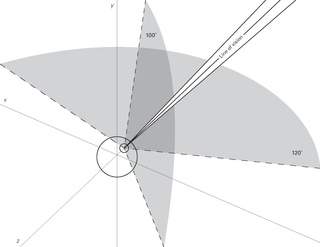Readability is the ease with which a reader can understand a written text. The concept exists in both in natural language and programming languages though in different forms. In natural language, the readability of text depends on its content and its presentation. In programming, things such as programmer comments, choice of loop structure, and choice of names can determine the ease with which humans can read computer program code.

Typing is the process of writing or inputting text by pressing keys on a typewriter, computer keyboard, mobile phone, or calculator. It can be distinguished from other means of text input, such as handwriting and speech recognition. Text can be in the form of letters, numbers and other symbols. The world's first typist was Lillian Sholes from Wisconsin in the United States, the daughter of Christopher Sholes, who invented the first practical typewriter.
Words per minute, commonly abbreviated wpm, is a measure of words processed in a minute, often used as a measurement of the speed of typing, reading or Morse code sending and receiving.

Subvocalization, or silent speech, is the internal speech typically made when reading; it provides the sound of the word as it is read. This is a natural process when reading, and it helps the mind to access meanings to comprehend and remember what is read, potentially reducing cognitive load.

Vision span or perceptual span is a controversial concept referring to the angular span, within which the human eye has sharp enough vision to perform an action accurately. The visual field of the human eye spans approximately 120 degrees of arc. However, most of that arc is peripheral vision. The human eye has much greater resolution in the macula, where there is a higher density of cone cells. The macula has a diameter of about 16 degrees of the retina. The field of view that is observed with sufficient resolution to read text typically spans about 6 degrees of arc, which is wide enough to allow a clear view of about five words in a row when printed text at ordinary size is held about 50 centimeters from the eyes. Regarding face processing, the field of view with a sufficient amount of information in order to recognise faces accurately spans about 7° which represents about 45% of a face. The brain creates the illusion of having a greater visual span by automatically and unconsciously moving the center of vision into any area of interest in the field of view.
Reading comprehension is the ability to process written text, understand its meaning, and to integrate with what the reader already knows. Reading comprehension relies on two abilities that are connected to each other: word reading and language comprehension. Comprehension specifically is a "creative, multifaceted process" that is dependent upon four language skills: phonology, syntax, semantics, and pragmatics.

Note-taking is the practice of recording information from different sources and platforms. By taking notes, the writer records the essence of the information, freeing their mind from having to recall everything. Notes are commonly drawn from a transient source, such as an oral discussion at a meeting, or a lecture, in which case the notes may be the only record of the event. Since the advent of writing and literacy, notes traditionally were almost always handwritten, but the introduction of notetaking software has made digital notetaking possible and widespread. Note-taking is a foundational skill in personal knowledge management.
SQRRR or SQ3R is a reading comprehension method named for its five steps: survey, question, read, recite, and review. The method was introduced by Francis P. Robinson, an American education philosopher in his 1946 book Effective Study.
Time-compressed speech refers to an audio recording of verbal text in which the text is presented in a much shorter time interval than it would through normally-paced real time speech. The basic purpose is to make recorded speech contain more words in a given time, yet still be understandable. For example: a paragraph that might normally be expected to take 20 seconds to read, might instead be presented in 15 seconds, which would represent a time-compression of 25%.
High frequency sight words are commonly used words that young children are encouraged to memorize as a whole by sight, so that they can automatically recognize these words in print without having to use any strategies to decode. Sight words were introduced after whole language fell out of favor with the education establishment.

Evelyn Nielsen Wood was an American educator and businessperson, widely known for popularizing speed reading, although she preferred the phrase "dynamic reading". She created and marketed a system said to increase a reader's speed by a factor of three to ten times or more, while preserving and even improving comprehension. The system was taught in rented offices dubbed "institutes" as Evelyn Wood Reading Dynamics, a business Wood co-founded with her husband, Doug Wood. It eventually had 150 outlets in the US, 30 in Canada, and others worldwide.
Sentence processing takes place whenever a reader or listener processes a language utterance, either in isolation or in the context of a conversation or a text. Many studies of the human language comprehension process have focused on reading of single utterances (sentences) without context. Extensive research has shown that language comprehension is affected by context preceding a given utterance as well as many other factors.
Speed learning is a collection of methods of learning which attempt to attain higher rates of learning without unacceptable reduction of comprehension or retention. It is closely related to speed reading, but encompasses other methods of learning, such as observation, listening, conversation, questioning, and reflection.
Microtypography is a range of methods for improving the readability and appearance of text, especially justified text. The methods reduce the appearance of large interword spaces and create edges to the text that appear more even. Microtypography methods can also increase reading comprehension of text, reducing the cognitive load of reading.
Slow reading is the intentional reduction in the speed of reading, carried out to increase comprehension or pleasure. The concept appears to have originated in the study of philosophy and literature as a technique to more fully comprehend and appreciate a complex text.

Reading is the process of taking in the sense or meaning of letters, symbols, etc., especially by sight or touch.
Miles Albert Tinker was an American author. He is "an internationally recognized authority on legibility of print" who published the results of some of the most comprehensive studies on the legibility of print ever conducted. According to Jeremy York, Tinker's work, along with his colleague Donald G. Paterson, "was a driving force behind the standardization of the print industry in the United States".
Word recognition, according to Literacy Information and Communication System (LINCS) is "the ability of a reader to recognize written words correctly and virtually effortlessly". It is sometimes referred to as "isolated word recognition" because it involves a reader's ability to recognize words individually from a list without needing similar words for contextual help. LINCS continues to say that "rapid and effortless word recognition is the main component of fluent reading" and explains that these skills can be improved by "practic[ing] with flashcards, lists, and word grids".
Garrett Stewart is an American literary and film theorist. He has served as the James O. Freedman Professor of Letters in the English Department at the University of Iowa since 1993.
Silent reading is reading done silently, or without speaking the words being read.










